Announcing: Blog On – Completely Rewritten for Spring 2018 (Here’s Why)
Blog On is currently open for registration: the first module begins on Monday 28th May. Registration closes at the end of this Thursday (24th May), so if you’re interested, do check it out as soon as you can!
Blog On (Spring 2018) – get all the details here
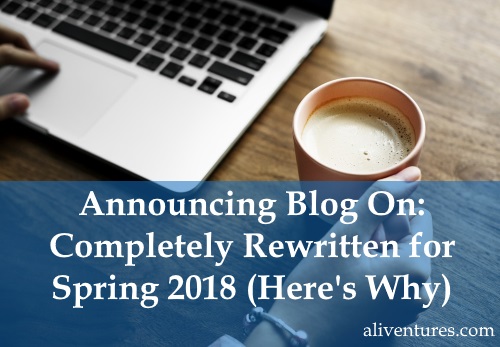
One of the reasons I closed Writers’ Huddle at the end of April was so that I could run more online courses – and Blog On has been the most frequently requested one.
In fact, when I ran a survey recently, it was the most popular option for “which course shall I run next?” … narrowly beating Launch Your Freelancing Career, as you can see here:
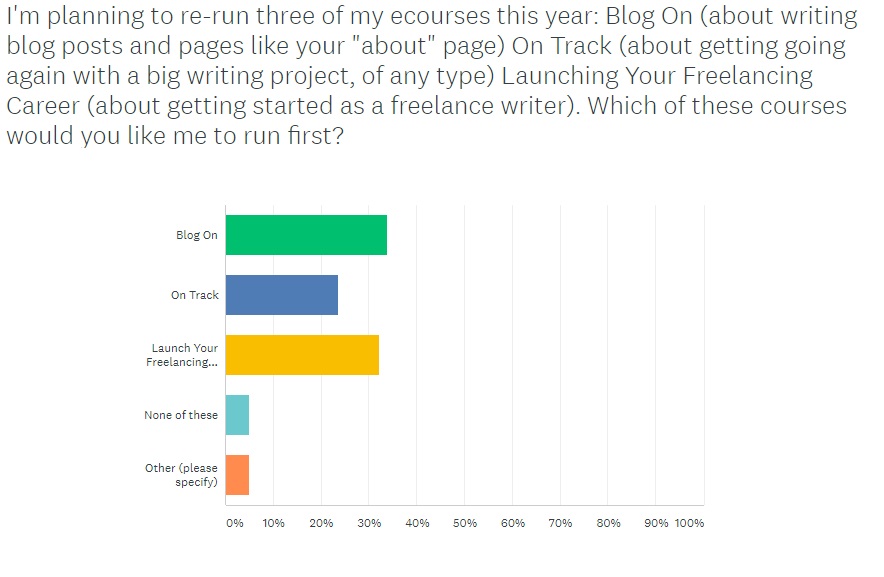
I first ran Blog On way back in 2011 (which feels like a lifetime ago now I have a five year old and a three year old…) and I’ve run it several time since, updating it each time.
For 2018, though, I wanted to overhaul the whole course completely.
Last time we ran through Blog On, I had some great feedback from members who were enjoying the course but who felt that their blogs didn’t quite “fit” with the materials and assignments. They were blogging as a hobby, for writing practice, or to grow a platform for their fiction … and I’d originally designed Blog On with money-making bloggers in mind.
This time round, I’ve recreated Blog On from the ground up – ditching some modules completely and rewriting others pretty much from scratch.
I’ve aimed to keep all the things that Blog On members have enjoyed over the years, with step by step guidance on how to craft posts and pages for your blog … but I’ve also broadened out the remit of the course so that all bloggers can enjoy it.
While I might well raise the price for future iterations of the course, I’ve also kept the current price to just $39.99 (less than $5/week).
Whatever sort of blogging you do (or hope to do!), Blog On could be just what you need to get moving again.
Why I Changed How I Deliver Blog On
A couple of months ago, I ran a survey of the Aliventures audience. (If you took part in that – thank you! :-))
I was particularly keen to find out what sort of course materials you prefer – video, audio or text – and how you like them to be delivered:
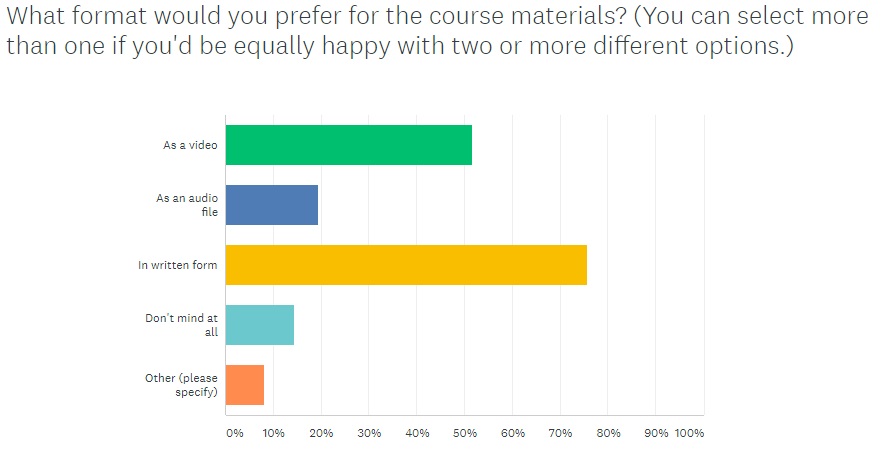
It wasn’t much surprise to learn that written materials were the most popular (this is what I’ve seen from past surveys, and it’s probably to be expected from an audience of writers)!
I’d not realised, though, how popular email delivery of the course materials would be:
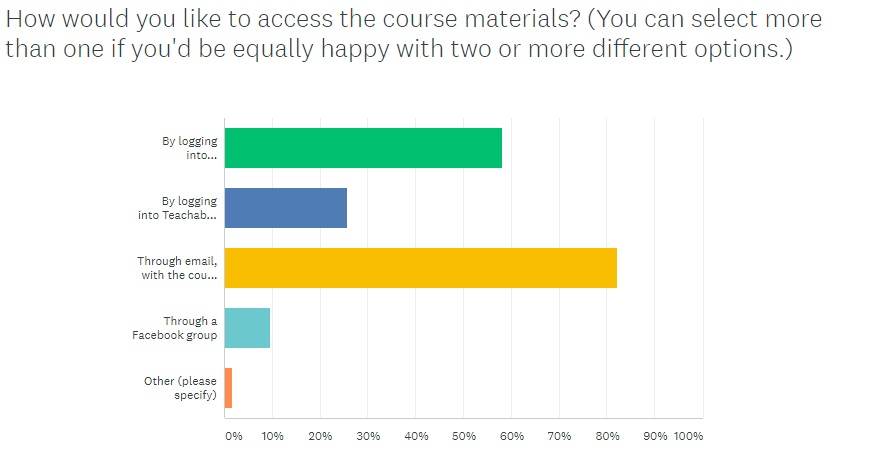
In fact, I’d been considering shifting Blog On to a platform like Teachable or Udemy – because I’d (erroneously!) assumed that potential students might prefer to use a big teaching site to access the materials.
In previous years, Blog On has been delivered online through my own website: members have logged in and read the modules as a series of web pages. This time round, I’ve turned the modules into .pdf files – easy to access on any device, and easy to save for future reference.
If you offer a course, service, book, blog or a newsletter to an audience … have you checked in with them recently about how they’d like to receive it? Like me, you might be surprised!
What Does the Shiny New Blog On Course Include?
As I mentioned earlier, I scrapped some Blog On modules and rewrote others considerable. Here’s the new line up of modules, and what you can expect from the course:
Module #1: What’s Your Blog All About … and Who’s Reading?
This module covers:
- Knowing why you’re blogging– understanding what you want to achieve with your blog
- Figuring out who you’re writing for— deciding on the readership you need to aim for to reach your goals
- Choosing (or refining) your blog’s topic– knowing what to write about in order to reach your ideal readers
Module #2: Classic Blog Post Structure: How to Get it Right
This module covers:
- The four key components of every blog post– the title, introduction, main body and conclusion
- Examples of how each of those elements works– we look at how three very different posts are put together
- How to get each section of your post right– by avoiding common mistakes and by using simple techniques effectively
Module #3: Your Contact Page: Clear, Concise … and Crucial
This module covers:
- Why a contact page is important– learn what to call it and where to place it in your blog’s navigation
- What to include on your contact page – so that it’s easy for your readers to connect to you in their preferred way
- How to write and structure your page– with a contact form to encourage readers to engage with you
Module #4: Writing a Great List Post that Readers Will Love
This module covers:
- Why list posts (with numbered sections) are so popular– and how to come up with a great idea for yours
- How to structure your list for maximum effect– whatever type of post you’re writing
- Ways to use a list structure to create different types of posts– from “how to”s to lists of recommended resources
Module #5: Your About Page: You, Your Blog … and Your Readers
This module covers:
- What to include on your About page– so you deliver the information that readers are looking for, and you establish a personal connection with them
- How to create an “About” snippet for your sidebar– to help make a connection with new readers
- Examples of About pages that you can learn from– plus tips on what not to do
Module #6: Advanced Formatting: Quotes, Links and Subheadings
This module covers:
- Why extra formatting can make all the difference– with “before” and “after” examples
- Different formatting elements you can use– with step-by-step instructions on quotes, links and nested subheadings
- How these elements can help you reach your goals–they aren’t just about the visual look and feel of your post
Module #7: Blog Pages: Services, Products, and Recommendations
This module covers:
- The difference between “posts” and “pages”– and knowing which you should use when
- Writing a “services” or “products” page – for bloggers who sell a service (like freelancing) or a product (like a book) from their blog
- Creating a “recommended resources” page – and why this is such a useful page for any blog to have
Module #8: Creating a Content Calendar Packed with Great Ideas
This module covers:
- What a content calendar is and why you need one – with different examples of how you can create it
- How to come up with ideas for your blog– even if you think you don’t have anything to write about
- Why “batch producing” posts is so helpful– and how to plan out several posts at once (you’ll finish this module with your next four posts outlined)
Sounds like it might be your sort of thing?
You can get the full details here:
… or click the button below to join straight away ($39.99 one-off payment for the full eight-week course; the materials are yours to keep for life).
Remember, Blog On closes for registration at the end of Thursday 24th May … so make sure you join before then. The sooner you sign up, the sooner you can get started with your Welcome pack, too!
About

I’m Ali Luke, and I live in Leeds in the UK with my husband and two children.
Aliventures is where I help you master the art, craft and business of writing.
Start Here
If you're new, welcome! These posts are good ones to start with:
Can You Call Yourself a “Writer” if You’re Not Currently Writing?
The Three Stages of Editing (and Nine Handy Do-it-Yourself Tips)
My Novels
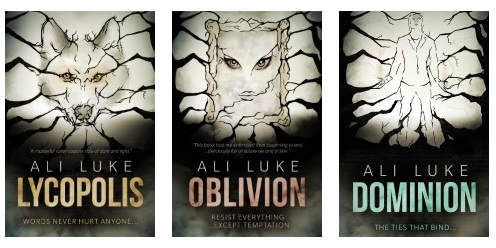
My contemporary fantasy trilogy is available from Amazon. The books follow on from one another, so read Lycopolis first.
You can buy them all from Amazon, or read them FREE in Kindle Unlimited.

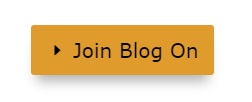
0 Comments